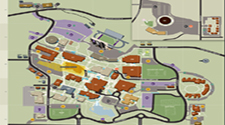
Viewing The Eclipse
August 21st, 2017 we have the opportunity to witness a rare historical event, a total solar eclipse. Less than 300 miles North of Ogden the eclipse will be passing over a large, resource-rich, part of our planet. Weber State College of Science is preparing for this event in a number of ways and is excited to offer some resources for our community to enjoy this experience. Be sure to read below how you can win a Weber Science T-shirt!
KNOW - READY - GO - RESEARCH -SHARE - WIN!
Know The Basics
August 12th, 2017 in Lind Lecture from 12 pm - 5 pm we will be focusing all our Science Saturday activities on the eclipse. Come learn about why the solar eclipse happens, why it is important for us to understand, and how you can be prepared to enjoy it to its fullest!
Get Your Eye Wear Ready
You don't need to be a scientist or engineer to enjoy this spectacle of our universe! But, you must be careful to protect your eyes when any portion of the Sun's bright surface is visible. It is important that you never look directly at the sun. Serious injury and even blindness can occur without proper eye protection. If you use eclipse glasses make sure they are not scratched or have any flaws like tiny holes. You can pick up free solar eclipse glasses, while supplies last, at Science Saturday and during the Ogden's Farmer's Market, August 19th. We hope you will come find us! In case you are not able to get some, here is a fun activity to build your own upgraded, pinhole projector.
NOTE: One of the most important things though is to take your eclipse glasses off during totality. That's the time, ranging from a few seconds to a couple of minutes when the Moon is completely covering the bright part of the Sun. During totality is the only time you can easily see our Sun's enormous atmosphere called the corona. Which is absolutely safe to view with your own eyes, just make sure to put your eclipse glasses back on the instant that even a tiny bit of the bright part of the Sun starts to be uncovered again.
Where To Go
It's important to know that a partial solar eclipse, which will be visible in Utah, is not the same experience. Only during totality can you see the huge halo of million-degree hot gas around our Sun. If we are lucky we'll even see solar flares along the edges with just our eyes. This is not possible even a few miles outside the path of a total solar eclipse.
Visit NASA's interactive map to see where the total eclipse will pass.
If you plan to visit a total eclipse location, make sure you plan ahead, bring plenty of food and liquids too. Comfortable chairs and a good book will make the wait more pleasant. Assume that there will be massive traffic jams, try to arrive early and allow yourself lots of time for a slow and casual drive home. With just a little bit of care, this can be a safe event that many people report as life-changing. For many people, a total solar eclipse is highly emotional and they become "eclipse chasers" spending the rest of their lives traveling to distant lands to see it again.
Science Research
NASA is taking advantage of this by sponsoring a wide range of research projects to study both the eclipse and the possible effects on our planet. The Weber State University Physics Department's HARBOR program has been funded by NASA to both video the eclipse from the stratosphere and to measure the atmosphere at the same time. Ozone will be especially interesting to measure since it is dependent on sunlight and goes through a normal daily cycle that might be impacted by the eclipse.
We have partnered with the Clark Planetarium to produce the video for global distribution to planetariums. We have also helped BYU-Idaho create their own high altitude balloon team and we are sharing research payloads and video systems with their HART team (High Altitude Research Team). We are also coordinating with numerous other teams including the University of Montana's BOREALIS team that will be flying near us in Idaho.
High altitude research balloon teams from around the nation are staging along the eclipse path to help make this one of the most carefully studied total solar eclipses ever. To follow the research visit the WSU HARBOR Facebook Group.
Share With Us Your Photos & WIN!
We would love to see how you enjoy the eclipse. Share your total eclipse experience on Facebook and tag us, @WeberScience. Make sure it is shared publicly (world icon) and if we share it on our CoS Facebook page you will get a free Weber Science T-Shirt! To know we have seen it, we will have liked it! *thumbs up* Then keep your eye on our page for it to be shared! Please note that by tagging us you are giving us the right to share it with our followers. Thank you!
Office Hours
Monday - Friday
8:30 a.m. - 4:30 p.m.
Mailing Address
Weber State University
College of Science
1415 Edvalson St., Dept. 2501
Ogden, UT 84408-2505
